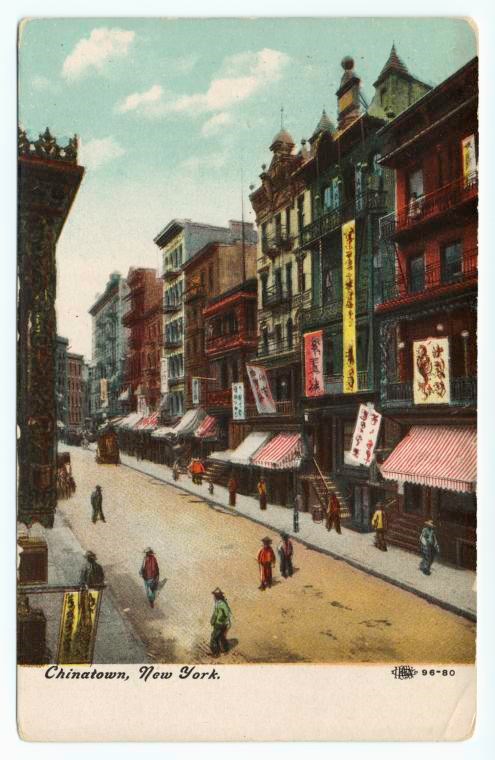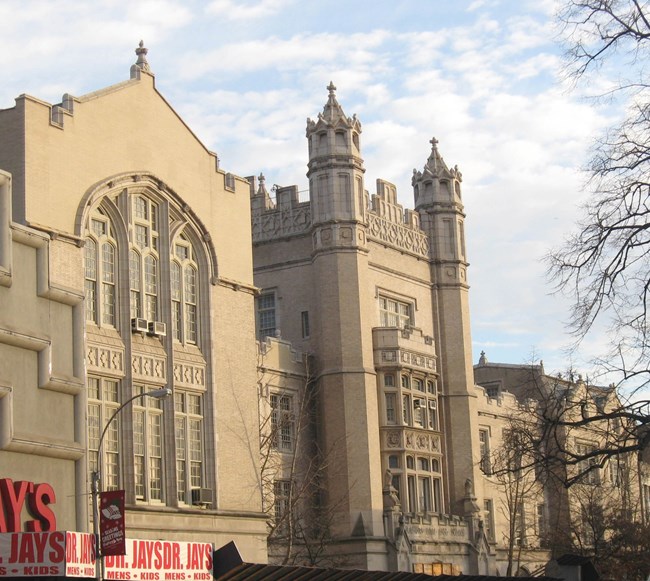Part of a series of articles titled Curiosity Kit: Dr. Mabel Ping-Hua Lee.
Article
The Places of Dr. Mabel Ping-Hua Lee
The content for this article was researched and written by Jade Ryerson, an intern with the Cultural Resources Office of Interpretation and Education.

Library of Congress, https://www.loc.gov/resource/ggbain.35680/
This article celebrates the life of Dr. Mabel Ping-Hua Lee, a Chinese immigrant and women’s suffragist advocate. It highlights places listed on the National Register of Historic Places, a National Park Service program.
Lee was born in Guangzhou (Canton), China in 1896 and later immigrated to the U.S. As a teenager in New York City, she marched in suffrage parades, wrote essays promoting women’s rights, and encouraged other Chinese women in her community to become involved with the movement. Even after the passage of the 19th Amendment, Lee herself was unable to vote due to the Chinese Exclusion Act.
In 1921, Mabel became the first Chinese woman to receive a doctorate from Columbia University; her degree was in economics. Following her father’s death in 1924, Mabel dedicated her life to supporting her community as director of the First Chinese Baptist Church and established the Chinese Christian Center. She died in 1966.
Map of New York City: The Places of Dr. Mabel Lee


https://digitalcollections.nypl.org/items/510d47e2-8b65-a3d9-e040-e00a18064a99
Place #1: Chinatown and Little Italy Historic District
Chinese immigrants between the 1870s and 1960s largely shaped the cultural and architectural landscape of Manhattan’s Chinatown and Little Italy Historic District. Starting in the 1870s and into the 1880s, Chinese immigrants in New York City increasingly moved to the area between Mott Street south of Canal Street, southern Mulberry Street, Bayard, Pell, Doyers, and Worth Streets to Chatham Square. As the population increased, Chinatown eventually enveloped much of what had been historic Little Italy, the Lower East Side, and the 6th Ward.
Among these immigrants was Mabel Ping-Hua Lee, who advocated for women’s suffrage as a student during the 1910s. Although the Chinese Exclusion Act restricted Mabel from voting even after the ratification of the 19th Amendment, she was committed to social and spiritual causes including her contributions to women’s suffrage and the local Chinese immigrant community. The Chinatown and Little Italy Historic District is located in Lower Manhattan.
Learn more about the Chinatown and Little Italy Historic District.

Photo of tall stone building. By Jim.henderson, Public Domain, https://commons.wikimedia.org/w/index.php?curid=5534245
Place #2: Erasmus Hall Academy/Erasmus Hall High School
First established in 1786, Erasmus Hall Academy underwent several changes in name and appearance as it sought to accommodate the growing immigrant population of New York City during the 1910s. Among these students, Chinese immigrant Mabel Ping-Hua Lee stands out. As a student, Mabel joined political organizations and drafted feminist essays promoting women’s education, independence, and equality. Her activism extended beyond the page and into national suffrage marches of 1912 and 1917 on Fifth Avenue.
Learn more about the Erasmus Hall Academy.

Arch in Washington Park with city in background. Photo by Isabella Ruffalo-Burgat, CC BY-SA 4.0
Place #3: Greenwich Village Historic District
Renowned for its cultural and political activity, Greenwich Village Historic District was the site of considerable energy supporting the women’s suffrage movement. In the 1912 suffrage parade, 20,000 suffragists marched up Fifth Avenue from Washington Square Park. At 16 years old, Mabel Ping-Hua Lee rode on horseback among them. As both a Chinese immigrant and a woman, Mabel was unable to vote. She advocated for women’s education and independence by participating in suffrage demonstrations and drafting feminist essays. Despite her efforts, her status as a Chinese immigrant prevented her from voting even after passage of the 19th Amendment.
Learn more about Greenwich Village Historic District.

Place #4: Barnard Hall/Students’ Hall, Barnard College
Completed in 1917, Students’ Hall became a hub for studying and socializing at New York City’s Barnard College. Because women were barred from attending Columbia University into the early 1900s, Barnard College prioritized women’s education and cultivated future activists including Chinese American suffragist Mabel Lee. Mabel participated in suffrage parades and wrote feminist essays while studying at Barnard. She went on to become the first Chinese American woman to receive a doctorate in economics from Columbia University.
Learn more about Barnard Hall at Barnard College.
![Historic Postcard of Low Memorial Library. “Low Memorial Library, Columbia University, New York City.” Postcard. Columbia Digital Library Collections [Columbia University Libraries.] Accessed December 10, 2019. Historic Postcard of Low Memorial Library. “Low Memorial Library, Columbia University, New York City.” Postcard. Columbia Digital Library Collections [Columbia University Libraries.] Accessed December 10, 2019.](/articles/images/image_8.jpg?maxwidth=650&autorotate=false)
Columbia Digital Library Collections [Columbia University Libraries.] https://dlc.library.columbia.edu/catalog/cul:cz8w9ghx89
Place #5: Low Memorial Library, Columbia University
Low Memorial Library is prominent for its history and its design. The central building on Columbia University’s campus, Low Memorial Library has housed offices, exhibitions, receptions, and was the first building erected after the university relocated to Morningside Heights. The structure is ambitious, much like Columbia’s student body and alumni, including Mabel Lee. Mabel was a Chinese immigrant, woman suffragist, and the first Chinese American woman to receive her doctorate in economics from Columbia in 1921.
Learn more about Low Memorial Library.
Explore More!
Discover more about Dr. Mabel Ping-Hua Lee at the National Park Service’s Asian American and Pacific Islander Heritage website and the Women’s History website.
Selected Sources:
Barnard College. “New York City’s Chinatown Post Office Named in Honor of Dr. Mabel Lee ‘1916.” News. Published December 3, 2018. https://barnard.edu/news/new-york-citys-chinatown-post-office-named-honor-dr-mabel-lee-1916.
“Chinese Girl Wants Vote.” New York Tribune, April 13, 1912: 3. Chronicling America: Historic American Newspapers. Library of Congress. https://chroniclingamerica. loc.gov/lccn/sn83030214/1912-04-13/ed-1/seq-3/.
“Chinese Women to Parade for Woman Suffrage.” The New York Times, April 14, 1912: X5. ProQuest Historical Newspapers: The New York Times with Index (1857-1922).
May, Grace. “Leading Development at Home: Dr. Mabel Ping Hua Lee (1896-1966).” William Carey International Development Journal. Published November 1, 2016. https://www.wciujournal.org/journal/article/leading-development-at-home-dr.-mabel-ping-hua-lee-1896-1966.
National Park Service. “Chinatown and Little Italy Historic District New York, New York.” Places. Last updated June 1, 2018. https://www.nps.gov/places/new-york-chinatown-and-little-italy-historic-district.htm.
New York Chinatown. “Chinatown History.” Accessed October 10, 2019. http://new-york-chinatown.info/chinatown-history/.
Tseng, Timothy. “Dr. Mabel Lee: The Interstitial Career of a Protestant Chinese American Woman, 1924-1950.” Paper presented at the Organization of American Historians Annual Meeting, Chicago, Illinois, 1996. https://timtsengdotnet.files. wordpress.com/2013/11/mabel-lee-paper-1996.pdf.
United States Department of the Interior, National Park Service. “National Register of Historic Places Registration Form: Chinatown and Little Italy Historic District.” Accessed October 10, 2019. https://www.nps.gov/nr/feature/asia/2010/ nychinatownlittleitalyhd.pdf.
Last updated: May 4, 2020
